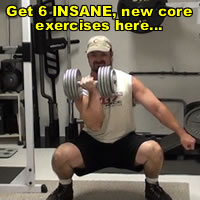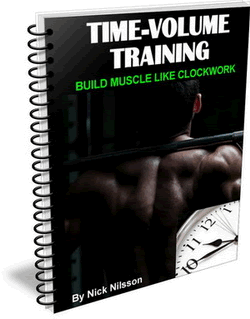In order to fully develop the entire core, you MUST also perform targeted anti-rotational ab movements that incorporate resistance.
This exercise is done using only a Swiss Ball and two dumbbells. You can achieve an extraordinary ab-tightening contraction around the entire midsection musculature. This exercise places a great stretch on the obliques along with great tension.
How To Do It:
For this exercise, you will need two dumbbells and a Swiss Ball (I will also tell you how to do the exercise on a regular flat bench in the Tricks section below). A smaller-size ball is better for this exercise though any ball will work.
Lay on your back with your knees bent and your feet fairly wide apart - you'll need a good base of support for this exercise so that you don't roll off to the side of the ball. Hold two equal-weight dumbbells at arms-length directly above you. Keep them pushed together while doing this exercise (if they're separated, they'll move around more, making the exercise less efficient). Start with fairly light dumbbells the first time you try this movement.
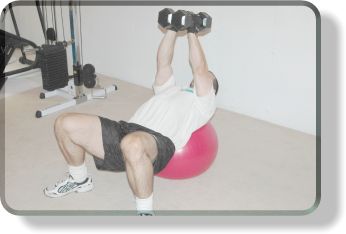
Now, keeping your head facing directly up/forwards and your hips horizontal, lower both of the dumbbells slowly and under complete control down to the left. Hold your breath and tighten up your midsection as you come down to the fully-twisted position. Prepare to push hard against the ground with your left foot to maintain your balance.
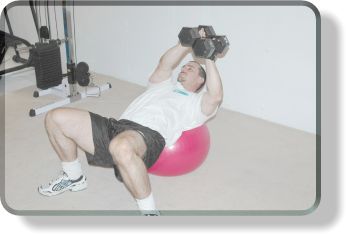
Your left arm is going to bend to about 90 degrees at the elbow as you lower the dumbbells to the side while your right arm should stay perfectly straight. Your upper body should stay in the same position on the ball - no rolling to the opposite side to compensate for the weight to the side.
This torque is what makes the exercise so valuable. Bending your lower arm is critical to keeping your torso in the same position on the ball.
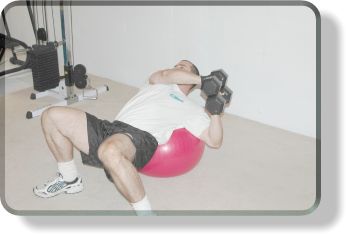
Since you're using two separate dumbbells, it's going to create a very different stress on the entire abdominal area than anything you've experienced before.
When you're at the bottom, your upper left arm will be contacting the surface of the ball (don't let it rest or lose tension at this point!). Reverse the direction by simultaneously pulling with your right side abs and pushing with your left side abs. The right arm movement is similar to a rear delt lateral while the left arm movement is similar to a dumbbell press.
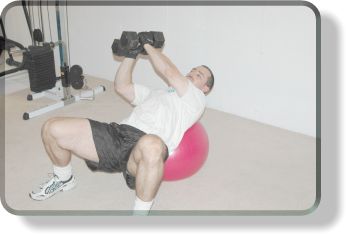
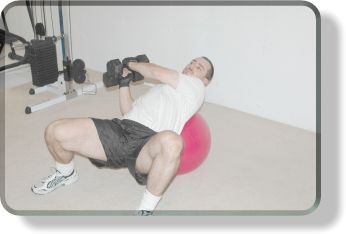
Remember to keep the dumbbells pushed together tightly. The opposing tension in the abs really puts a lot of torque across the whole area. Be very sure you're not just pushing with the bottom arm but that you're also pulling with the top arm.
Be sure not to bounce out of the bottom, but try to feel a stretch in the right side as you start the change of direction.
If you have any lower back pain issues, this exercise does put some stress on the lower back. If you do try it, go very light and take it very slowly.
Common Errors:
1. Separating the dumbbells
Keep them pressed together throughout the movement. If they separate, they're harder to control and it disperses the tension on the abs.
2. Rolling around on the ball
For best results, be sure to keep yourself as stationary as possible on the ball. If you roll to the side, it takes some of the torque off the abs and it won't hit the abs as strongly.
3. Moving too quickly
This is NOT a ballistic exercise - there should be no bouncing or fast movements involved. Lower the dumbbells slowly to the sides and change direction very deliberately by using muscle power, not bouncing.
Tricks:
1. Changing the arc
You can bring the dumbbells down at various angles to the torso to change where the exercise hits your abs. By bringing them down higher up beside your head, you'll hit the upper areas of your obliques.
By bringing them down towards your hip, you'll hit the lower areas of your obliques. Just remember to always keep your head looking straight up and set your feet wide apart for the best base of support.
2. How to use a flat bench instead
You can also do this exercise on a flat bench instead of a ball, if you don't have access to a ball or prefer a more solid surface to work on. Instead of lying flat on the bench as you normally would for a bench press, you'll be resting only your upper back on the end of the bench.
To get into this position, sit on the very end of the bench. Now move your butt off the bench and squat down in front of it. Lean back and place your upper back on the bench end. Keep your hips down and set your feet fairly wide apart.
This is the position you should maintain while doing the exercise. The bench is a more solid surface but it is just as effective for the exercise. One major difference is that there won't be any surface to contact the upper arm of the bottom arm as you lower the weight down. Keep an eye on how far down you go to the side. All the other techniques still apply.
3. When using heavier weight...
- You can shift your upper body somewhat to the other side of the ball. If you're using a heavy weight, you'll need to do that in order to stay on the ball. The increased resistance will make up for it.
- Be extra careful the dumbbells don't separate. It'll be much harder to control heavier dumbbells if they do.
- As you rotate back up, exhale through pursed lips to keep stability in your abs as you let air out and so that you don't pass out.
- Push VERY hard with the same side leg as the weight is on. You'll need all the help you can get.
Another excellent anti-rotational core exercise is Dumbbell Crawling.
![]()
More From Fitstep.com
| Multiply Your Muscle Fibers...How to Train for Hyperplasia | |
| 5 Fat-Loss Myths That Are KILLING Your Results | |
| 7 Simple Rules for What You Should Eat | |
| Laser-Target Your Lower Abs With See-Saw Leg Raises |
Share This Page...
---
Home -> Exercise Library -> Abdominal Exercises -> Two Dumbbell Ball Twists


